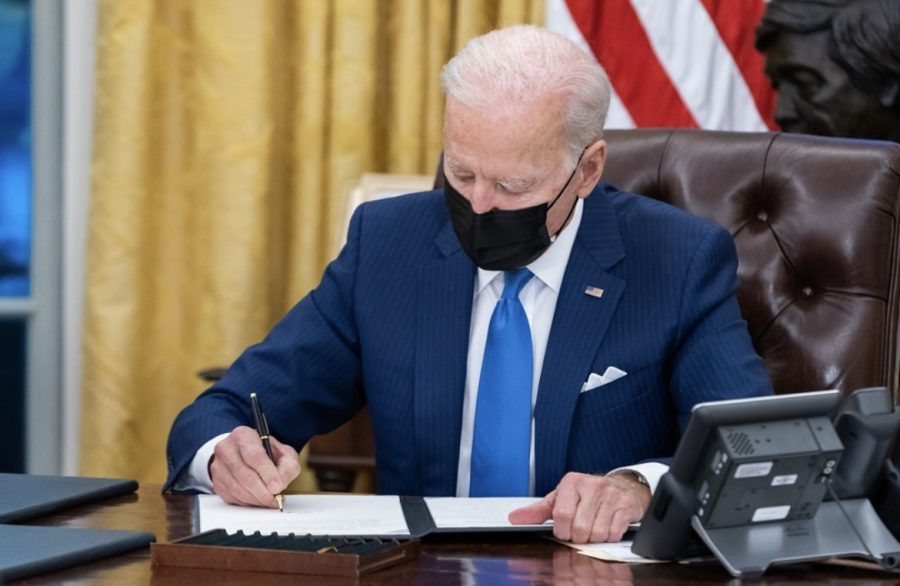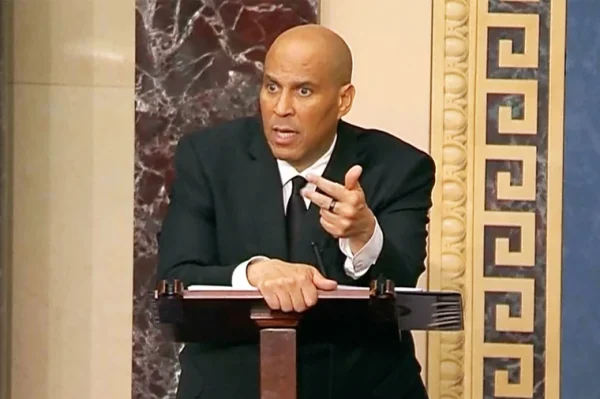Executive Orders: Helpful or Harmful?
President Biden signing an executive order
On Jan. 25, 2017, President Trump issued executive order 13767, Border Security and Immigration Enforcement Improvements. This order issued a wall to be built along the Mexican-American border to stop immigration into the United States from that border.
Jan. 20, 2021, President Biden signed an executive action that revoked Trump’s order, putting a halt to the construction of the southern border wall.
Biden has so far signed eight executive actions regarding immigration which undoes Trump’s initiatives on the matter during his presidency. Although many agree with Biden’s executive actions and believe that they are intended for the greater good of our country, many believe it seems unjust that Biden signed these actions and quickly reversed much of Trump’s work over the past four years. Executive orders allow for the president to make laws very quickly without having to get approval from other branches. The power executive orders grant serving presidents has become controversial throughout our country.

Executive orders, as defined by the Oxford Dictionary, are rules or orders issued by the president to an executive branch of the government and having the force of law. When presidents take office, they often use executive orders in response to emergent situations, or to get an action that is important to their vision of the country in motion. As History.com states, “With an executive order, the president instructs the government how to work within the parameters already set by Congress and the Constitution. In effect, this allows the president to push through policy changes without going through Congress.” Moreover, when a president issues an executive order, it is not a new law and does not allocate money from the U.S. Treasury; only Congress has the power to do that. Overall, this is saying that an executive order is made by the president without having to go through other branches of the government. As a result of this, this order cannot go against the constitutional laws we have already made, just set new restrictions/rules which fall within our set of laws.
Once a president signs/issues an executive order, it is recorded in the Federal Register. (The Federal Register is the official journal of the United States Federal Government where rules and public notices are recorded.) “After the president issues an executive order, that order is considered binding which means it can be enforced in the same way as if Congress had enacted it as law,” History.com states. Executive orders have checks and balances in place to ensure they are constitutional. They can be repealed by federal courts or the Supreme Court, and Congress can repeal an executive order by making new laws.
But where do presidents get their power to issue these actions, legally speaking?
The Constitution does not explicitly grant the president’s authority to issue executive actions, nor does it directly mention it. This implied authority of executive orders comes from Article II of The Constitution. This article explains the power/responsibilities of the president. Article II, section 3 states, “He shall take Care that the Laws be faithfully executed.”
Executive orders are helpful to our country in difficult times. If our country needs help promptly in a bad situation, executive orders may immediately cause our country relief. For instance, in 1948, President Harry Truman issued executive order 9981: Establishing the President’s Committee on Equality of Treatment and Opportunity in the Armed Services. This order stated, “It is hereby declared to be the policy of the President that there shall be equality of treatment and opportunity for all persons in the armed services without regard to race, color, religion or national origin.” This was a huge step forward in desegregating the U.S. military.
Executive orders may also cause harm to our country. If orders are unjust in certain respects, they could end up hurting our country as a whole, or hurt specific, mainly minority, groups of people. For instance, in 1942, President Franklin D. Roosevelt issued executive order 9066: Authorizing the Secretary of War To Prescribe Military Areas. This order ended up causing harm to Japanese-Americans, for as a result of this order being in place, more than 100,000 Japanese-American immigrants were sent to internment camps.
As seen, executive orders can both help and harm our country. Different people may argue for/against an order based on if it suits them and their belief system. In the current times, political parties hold opposing views on the executive orders passed by newly-elected President Biden. Biden issued 17 executive orders on his first day in office. Out of these 17, nine reversed some of Trump’s seemingly controversial policies. Three of his executive orders were in regards to COVID-19.
Biden started his presidency amid a national crisis. In addition to the ongoing pandemic, the United States is currently very divided, as Democrats and Republicans clash over various issues. These issues heavily regard Trump’s presidency and the change he made to our country. Although most Republicans believe Trump changed our country for the better, Democrats believe he had a detrimental effect on our country and what it stands for.
Democrats are seemingly satisfied and thankful for Biden’s first day-executive actions. In the eyes of most Democrats, he not only undid Trump’s controversial orders, but he also made strides towards obtaining a level of safety during the COVID-19 pandemic. For instance, Biden launched the 100-day mask challenge, stopped the U.S. withdrawal from WHO (World Health Organization) and instated Dr. Anthony Fauci as their Head of Delegation, and created a new position called COVID-19 Response Coordinator — which manages vaccine and medical equipment distribution and reports directly to the president — all on his first day. Biden responded to national emergencies by making rules to ensure general welfare through these COVID-19 executive actions.
Republicans, on the other hand, are not pleased with Biden’s various executive orders. They view the number of executive orders issued as an abuse of power. Biden was in office for only 24 hours and already made 17 modifications to our country. In the eyes of most Republicans, the change Trump worked on for four years was now all undone by a president using too much personal power in too quickly of a manner.
Although the questioning of executive orders is occurring now, it has not only been a prevalent issue in this election. In the 2016 election, the same question also arose, as Democrats viewed the executive actions by President Trump as an abuse of power. Whereas, Republicans viewed the executive actions by President Trump as necessary and helpful. The pattern that is seemingly occurring is that the party that has won the election agrees with the orders passed and they benefit from them, for the orders reflect their belief system. Contrarily, the party which has lost the election sees the executive orders as an abuse of power and unjust, for the executive actions do not reflect what they believe in and seem to be passed too suddenly and easily.
Another question that has arisen regarding executive orders is, “If presidents continuously use executive powers to undo the doings of the prior president, will real change stay in place?” If Republicans are successful at getting the Democrats out of the office and getting their own elected official in office, and Democrats do the same in the following election, will the laws of the country ping-pong every election year, causing no real movement forward?
In certain cases, it has been shown that executive orders give too much power to the executive branch which has caused injustices within our country. However, in other situations, executive orders have restored justice to our country and given the president enough power to improve our nation’s condition. This presents America with a conundrum: Do executive orders cause more harm or help, and how effective do they turn out to be in the long run? The answer seems to be that executive orders in themselves are neutral, but how they are used determines their effectiveness. Take, for instance, a hammer. It matters a great deal who is holding the hammer and whether they use it to build a home or to harm a person.

Hi! I am Aria Dwoskin, and this year I am the Editor-in-Chief of the Berkley Spectator! I am a senior, and this is my fourth year on The Spectator. I...







